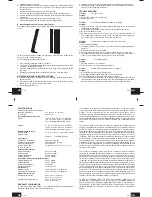
TABLE OF CONTENTS
Topic
Page
Inventory of Contents/ Additional Equipment
3
About WWVB
3
Quick Set Up Guide
4
Detailed Set Up Guide
Battery Installation
4
Start Up Sequence
6
Explanation of LCD Information
7
Function Key Layout
8
Program Mode
Overview of Programming Sequence
8
LCD Contrast Setting
8
Time Zone Setting
8
DST ON/OFF Setting
9
Radio-controlled Time ON/OFF Setting
9
12/24-hour Time Mode Setting
9
Setting the Time/Date Manually
9
Temperature Measuring Units (˚F/˚C)
11
Air Pressure Measuring Units (inHg/hPa)
11
Relative Pressure Setting
11
Forecast Sensitivity Setting
11
Features and Operation
Time Alarm Setting and Operation
12
Moon Phase
13
Minimum/Maximum Temperature/Humidity
13
Multiple Remote Temperature/Humidity Sensors
14
Comfort Icon
15
Weather Forecast and Pressure Trend Indicators
15
Weather Icons
15
Weather Tendency Arrows
16
Barometric Air Pressure Reading
16
Air Pressure History Bar Chart
16
Mounting
17
Maintenance and Care
18
Troubleshooting Guide
19
Specifications
20
Warranty Information
20
INVENTORY OF CONTENTS
1. WS-9032U-indoor weather station
2. TX4U-remote thermo/hygro (temperature/humidity) sensor
3. Instruction manual and warranty card
ADDITIONAL EQUIPMENT (not included)
1. Five fresh AA 1.5V alkaline batteries.
2. One wall-mounting screw (optional)
ABOUT WWVB (radio-controlled time)
The NIST (National Institute of Standards and Technology-Time and Frequency
Division) radio station, WWVB, is located in Ft. Collins, Colorado and transmits the
exact time signal continuously throughout the United States at 60 kHz. The signal
can be received up to 2,000 miles away through the internal antenna in the indoor
weather station. However, due to the nature of the Earth’s Ionosphere, reception is
very limited during daylight hours. The indoor weather station will search for a signal
every night when reception is best. The WWVB radio station derives its signal from
the NIST Atomic clock in Boulder, Colorado. A team of atomic physicists continually
measure every second of every day to an accuracy of ten billionths of a second a
day. These physicists have created an international standard, measuring a second
as 9,192,631,770 vibrations of a Cesium 133 atom in a vacuum. For more informa-
REMOTE
THERMO-SENSOR
433 MHz
tion about WWVB please see the NIST website at http://www.boulder.nist.gov/
timefreq/stations/wwvb.htm
QUICK SET-UP GUIDE
Hint:
Use good quality Alkaline Batteries and avoid rechargeable batteries.
1. Have the indoor weather station and remote thermo/hygro sensor 3 to 5 apart.
2. Batteries should be out of both units for 15 minutes.
3. Place the batteries into the
remote thermo/hygro sensor
first then into the in-
door weather station.
(All remote thermo/hygro sensors must be started before the indoor weather
station)
4. DO NOT PRESS ANY BUTTONS FOR 15 MINUTES.
In this time the indoor weather station and remote thermo/hygro sensor will start to
talk to each other and the indoor weather station will show both the indoor tempera-
ture and humidity and the outdoor temperature and humidity. If the indoor weather
station does not display all values after the 15 minutes please retry the set up as
stated above. After all values are displayed for 15 minutes you can place your re-
mote thermo/hygro sensor outdoors and set your time.
The remote thermo/hygro sensor should be placed in a dry, shaded area. The re-
mote thermo/hygro sensor has a range of 330 feet. Any walls that the signal will
have to pass through will reduce distance. An outdoor wall or window will have 20 to
30 feet of resistance and an interior wall will have 10 to 20 feet of resistance. Your
distance plus resistance should not exceed 330 ft. in a straight line.
NOTE:
Fog and mist will not harm your remote thermo/hygro sensor but direct rain
must be avoided.
To complete the set up of your indoor weather station after the 15 minutes have
passed please follow the steps in the Detailed Set Up Guide.
Note:
The remote thermo/hygro sensor transmits a signal every 3 minutes; after the
batteries have been installed, the indoor weather station will search for the signal for
a duration of 5 minutes. If there is no temperature reading in the OUTDOOR LCD
after 5 minutes, make sure the units are within range of each other, or repeat the
battery installation procedure.
DETAILED SET-UP GUIDE
I. Battery Installation
Batteries will fit tightly. To avoid start-up problems, make sure that the batteries do
not spring free. Also be sure to insert alkaline batteries into the remote thermo/hygro
sensor first, then the indoor weather station. Initial set up should be done with the
remote thermo/hygro sensor and indoor weather station in the same room. The units
should be permanently mounted only after the signal reception has been verified.
A. Remote Temperature and Humidity Sensor
1. Pull the cylindrical rain cover off the transmitter.
2. Remove the battery cover (located on the backside of the transmitter, above the
mounting post and bracket). Press the arrow and slide the battery cover off.
3. Observing the correct polarity install 2 Alkaline AA batteries.
4. Replace battery cover, and place rain cover snugly onto the transmitter.
B. Indoor Weather Station
1. Remove the battery cover (the cover has white writing on it).
2. Observe the correct polarity, and install three Alkaline AA batteries.
+
+
+
SIZE AA LR6
SIZE AA LR6
SIZE AA LR6
GB
P.2
GB
P.3
GB
P.4
GB
P.5
Battery Cover
REMOTE
THERMO-SENSOR
433 MHz
+
SIZE AA LR6
+
SIZE AA LR6
Rain Cover
Mounting
Bracket / Recent
Thermo-Hygro
Transmitter



























